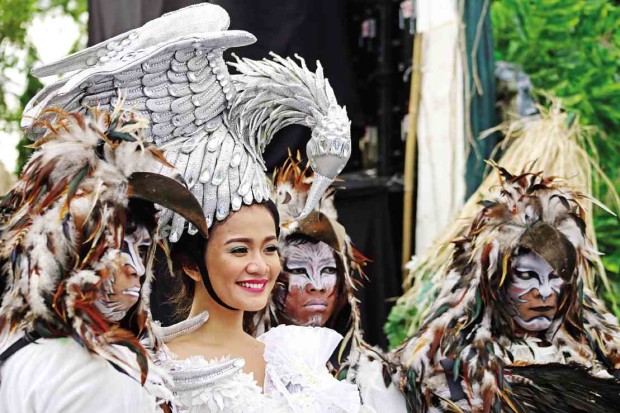
TAKING FLIGHT Wearing eagle-inspired costumes, street dancers join the launch of the 18th Philippine Eagle Week to call attention to the plight of the endangered eagles in the wild. KIMBERLY DELA CRUZ
STA. ROSA CITY—Flapping their arms like real wings, children came prancing in feathery costumes to mimic the movement of the majestic Philippine eagle.
There were adults too, garbed in elaborate boas and dresses, one of them with an eye-catching eagle headdress.
These “eagles” landed at the Enchanted Kingdom here as the 18th Philippine Eagle Week kicked off on Saturday.
Jesselyn Rodriguez, a regular guest at the theme park, said she had heard about the activities and wanted her 6-year-old daughter to take part in the eagle-themed coloring contest.
Employees of the Department of Environment and Natural Resources’ Biodiversity Management Bureau (DENR-BMB) joined the “agilaro,” a race around the 10-hectare park, while completing environment-related puzzles and questions.
Critically low
The set of fun activities was a way for the environmental groups, Philippine Eagle Foundation (PEF) and Haribon, to air a rather tragic situation of Philippine eagles in the wild.
“We know that President-elect [Rodrigo] Duterte is tough on crimes and [illegal] drugs [but] we’re urging [him] to also take a look into crimes against nature,” said Dennis Salvador, PEF executive director, on the sidelines of the activity.
Only 400 pairs of the Philippine eagle (Pithecophaga jefferyi) remain in the wild, making the population of the endemic species “critically low.”
More than half of these eagles were killed before they reached adulthood (seven years), leaving only a few to replace the old breeding population.
“Within a decade, we could be facing a sudden population crash,” Salvador said.
‘Pamana’
“These pamana (legacies) to the next generations are similarly in peril,” he said.
“Human persecution,” through shooting and hunting, deforestation and loss of habitat remain the top threats to their dwindling population, he added.
“The funny thing is there’s no illegal trade,” Salvador said. “People hunt them down just because they have guns.”
In 2015, a 3-year-old Philippine eagle named Pamana was shot dead inside the Mt. Hamiguitan range wildlife sanctuary in Davao Oriental province. The killing inside a protected area prompted a Senate inquiry late last year.
Sadly, “such message did not resonate [in the Senate],” Salvador said, noting that not much had taken place since.
Awareness campaign
Salvador said that while his foundation had identified Pamana’s hunters, no arrests had been made.
“We have so much laws (promoting wildlife conservation) but these don’t get enforced. As a result, many people think they can practically get away with anything [with] our values eroding as a society,” he said.
BMB Director Theresa Mundita Lim lauded what she called a “perfect” partnership between the government, environmental groups and the private sector to protect the Philippine eagle.
With 1.7 million guests annually, Lim said Enchanted Kingdom was in a position to help educate people, especially its young patrons, on wildlife conservation.
Mario Mamon, the park’s chair and president, said he wanted “to elevate [our] brand of entertainment and amusement to [make it] also educational.”
In October last year, Enchanted Kingdom adopted a male Philippine eagle in captive breeding and named it “Enchanting Kagitingan.”
Mamon said the amusement park was also dedicating a new ride to open later this year to the Philippine eagle. A “flying theater,” to be named Agila, would simulate paragliding using mock eagle wings, he said.
The six-minute ride, he said, simulates “the flight of the eagles [which would also] become the plight of the eagles.”